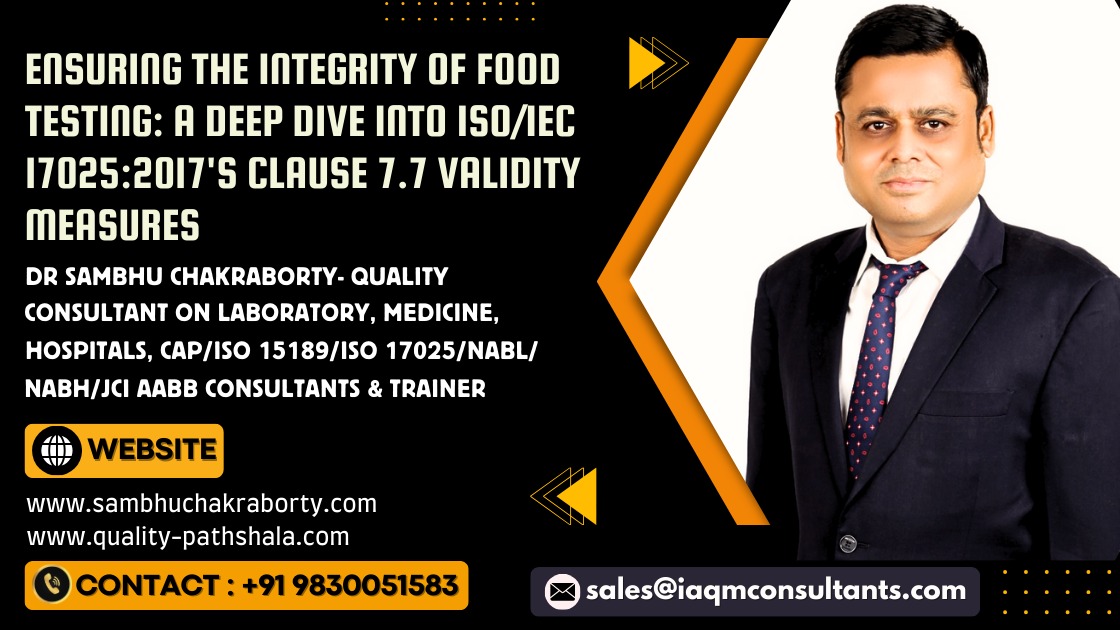In the realm of food testing laboratories, maintaining the integrity and validity of test results is paramount. ISO/IEC 17025:2017, specifically in clause 7.7, outlines the importance of monitoring the validity of results to ensure reliability and trustworthiness. The standard mandates that laboratories implement procedures to keep a vigilant eye on their output, ensuring that any patterns or inconsistencies are promptly identified and addressed.
Here are some examples of how food testing laboratories might implement the requirements of ISO/IEC 17025:2017:
- Use of Reference Materials or Quality Control Materials: A food testing laboratory could use certified reference materials to ensure the accuracy of test results. For instance, when measuring the vitamin C content in fruit juice, the laboratory could use a reference material with a known quantity of vitamin C to calibrate its instruments.
- Use of Calibrated Instrumentation: All instruments used in testing, such as spectrophotometers for color analysis in food, should be calibrated with traceable standards to ensure accurate results.
- Functional Checks of Equipment: Routine checks on equipment, like pH meters and balances, are essential. A laboratory might implement a daily verification of balance accuracy with a known weight before any sample measurement.
- Use of Control Charts: Control charts could be utilized for ongoing processes such as the pasteurization of milk, where the temperature and time control points are continuously monitored to detect any drift that could affect the quality of the outcome.
- Replicate Testing: To validate results, a laboratory might perform duplicate tests on a sample of ground meat to check for the presence of E. coli. If the results from the two tests match, the laboratory can be more confident in the accuracy of the testing process.
- Retesting or Recalibration: If a batch of food products shows unexpected levels of a contaminant, retesting or recalibration of the instruments used may be necessary to confirm the results.
- Intralaboratory Comparisons: The laboratory could conduct intralaboratory comparisons, where the same test is performed by different analysts using the same method to ensure consistency across the board.
- Proficiency Testing: Participating in external proficiency testing, where the laboratory’s results for a given test are compared against those from other laboratories, can be a way to ensure the external validity of results.
- Interlaboratory Comparisons: Engaging in interlaboratory comparisons beyond proficiency testing, such as collaborative studies on food allergen detection methods, to benchmark performance and drive improvements.
- Use of Alternative Instrumentation (Clause 7.7.1b): Suppose a food testing lab typically uses gas chromatography for pesticide residue analysis. To ensure validity, they might also employ an alternative method, like liquid chromatography-mass spectrometry (LC-MS), for a subset of samples. If both instruments yield comparable results, it affirms the reliability of the test methods.
- Intermediate Checks on Measuring Equipment (Clause 7.7.1e): A food lab conducts daily intermediate checks on its thermometers used in cooking oil quality assessment. By comparing readings against a known reference, the lab ensures ongoing accuracy between regular calibrations.
- Correlation of Results (Clause 7.7.1h): When analyzing the nutritional content of a food product, a lab may measure both the vitamin A content using HPLC and the beta-carotene levels using spectrophotometry. Correlating these results can validate the tests since beta-carotene is a precursor to vitamin A, and their levels should be related.
- Review of Reported Results (Clause 7.7.1i): Before releasing a report on microbial contamination in packaged food, the results undergo a peer review within the lab to ensure that interpretations align with the observed data and that the report reflects all relevant quality controls.
- Testing of Blind Samples (Clause 7.7.1k): To test the lab’s accuracy, blind samples spiked with a known quantity of a food allergen might be introduced into the routine workflow. If the lab correctly identifies and quantifies the allergen in these samples, it validates the testing process’s robustness.
The data derived from these monitoring activities is then analyzed and used to manage and improve laboratory operations. Should this data highlight results that deviate from established criteria, immediate and appropriate action must be taken. For instance, if a lab consistently finds its pesticide residue analyses are higher than those obtained in proficiency testing, it may need to investigate and rectify potential issues with its testing methods or instrument calibration.
The goal of these procedures, as per ISO/IEC 17025:2017, is to ensure that food testing laboratories not only produce results that are reliable and repeatable but also that they strive for continuous improvement in the accuracy and efficiency of their testing processes.
About the Author
Dr. Sambhu Chakraborty is a distinguished consultant in quality accreditation for laboratories and hospitals. With a leadership portfolio that includes directorial roles in two laboratory organizations and a consulting firm, as well as chairmanship in a prominent laboratory organization, Dr. Chakraborty is a respected voice in the field. For further engagement or inquiries, Dr. Chakraborty can be contacted through email at director@iaqmconsultants.com and info@sambhuchakraborty.com. Additional resources and contact information are available on his websites, https://www.quality-pathshala.com and https://www.sambhuchakraborty.com or via WhatsApp at +919830051583.
